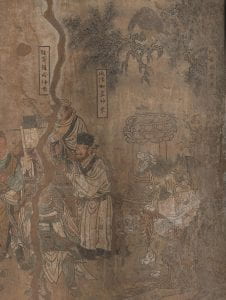Sun, Bo. PhD., Visiting Scholar, Department of History of Art and Architecture, Harvard University; Associate Research Professor and Director of Science and Art Office, Exhibition Department in the National Museum of China
“A Complimentary Study of shuilu-hua (the Painting of Water-and-Land Rituals) in Qinglong Temple (Temple of Blue Dragon) in Jishan County (Shanxi, China) (稷山青龙寺水陆画考补)”
Discussant: Tao, Jin. Master’s student, Divinity School
This talk will be delivered in Chinese.
Friday, May 8, 2020
4:30-6:30 pm, Zoom meeting (please find the registration link below)
Abstract: The “Water-and-Land Ritual” (shuilu fahui水陆法会) was one of the most elaborated Buddhist rites developed in China for the universal salvation of the deceased and all sentient beings. The “Water-and-Land Painting” (shuilu hua 水陆画), which is an indispensable visual aid to this ritual, was often painted in Buddha halls or on hanging scrolls. It is one of the major subject matters of Chinese Buddhist painting since the Middle Periods. Among the numerous Water-and-Land Paintings that exist in China, the earliest example is a mural circle in the Middle Buddha Hall of the Qinglong Monastery (the Monastery of Blue Dragon), which was painted during the Yuan Dynasty (1279–1368). The Qinglong mural preserves many early features of the Water-and-Land Painting, such as a special and rigorous composition. The Qinglong mural, which differs from later paintings of the Ming (1368–1644) and the Qing periods (1644–1911), deserves a comprehensive case study. Since the publication of the author’s Master’s Thesis titled “A Study of The Mural Paintings in The Qinglong Monastery in Jishan County — With a Focus on The Water-and-Land Painting in The Middle Hall” (稷山青龙寺壁画研究——以腰殿水陆画为中心) in 2010, several North American scholars have conducted new researches based on the author’s primary study. In the past decade, gladly, new evidences have been found. These evidences not only approve some of the author’s theses, but also allow him to elucidate some painting details that initially appeared obscure. In these seemingly trivial details, the author finds a new approach to the meanings and the historical developments of the Water-and-Land Painting. In this talk, he will discuss five of the important details that shed light on the Qinglong mural and the genre of the Water-and-Land Painting.
A detail of the Water and Land mural painting, southern wall, the Middle Buddha Hall of the Qinglong Monastery, Yuan dynasty.
You can download Sun Bo’s pre-circulated materials here with the password shuilu.
Zoom Registration Link: https://uchicago.zoom.us/meeting/register/uZQsdOugrDsqfA9q4LSbPDDo1bcEpTNIrA
++++++++++++++++++++++++++++
Dr. Sun, Bo is an Associate Research Professor and Director of Science and Art Office, Exhibition Department in National Museum of China. Since 2010, he has participated in curating a series of exhibitions hosted by the National Museum of China ranging from ancient archaeology to contemporary art. In terms of research, his academic interests focus on Chinese religious art after the tenth century, and material and visual culture exchange in Eurasia. As a visiting scholar of CAMLab, he currently engages in three research or exhibition projects including paintings used for shuilu rites (水陸法會), and visual representation of Avatamsaka Sutra and Chan’an of Tang dynasty.
Tao, Jin is a 2nd year MA student at the Divinity School University of Chicago, and also a practicing architect based in Beijing. Jin’s previous architectural projects mainly attribute to religious typology, especially a few Taoist temples in the sacred mountain in the south of China. His research interests cover the comparative study between Jewish and Taoist theology, ritual practice of ancient Chinese religions, and the sacred space generated by the body concepts, ritual actions, religious thoughts, and social structures. His current book in progress is The Covenant: The Religious Ethos and Conferral Liturgy of Taoist Register.
